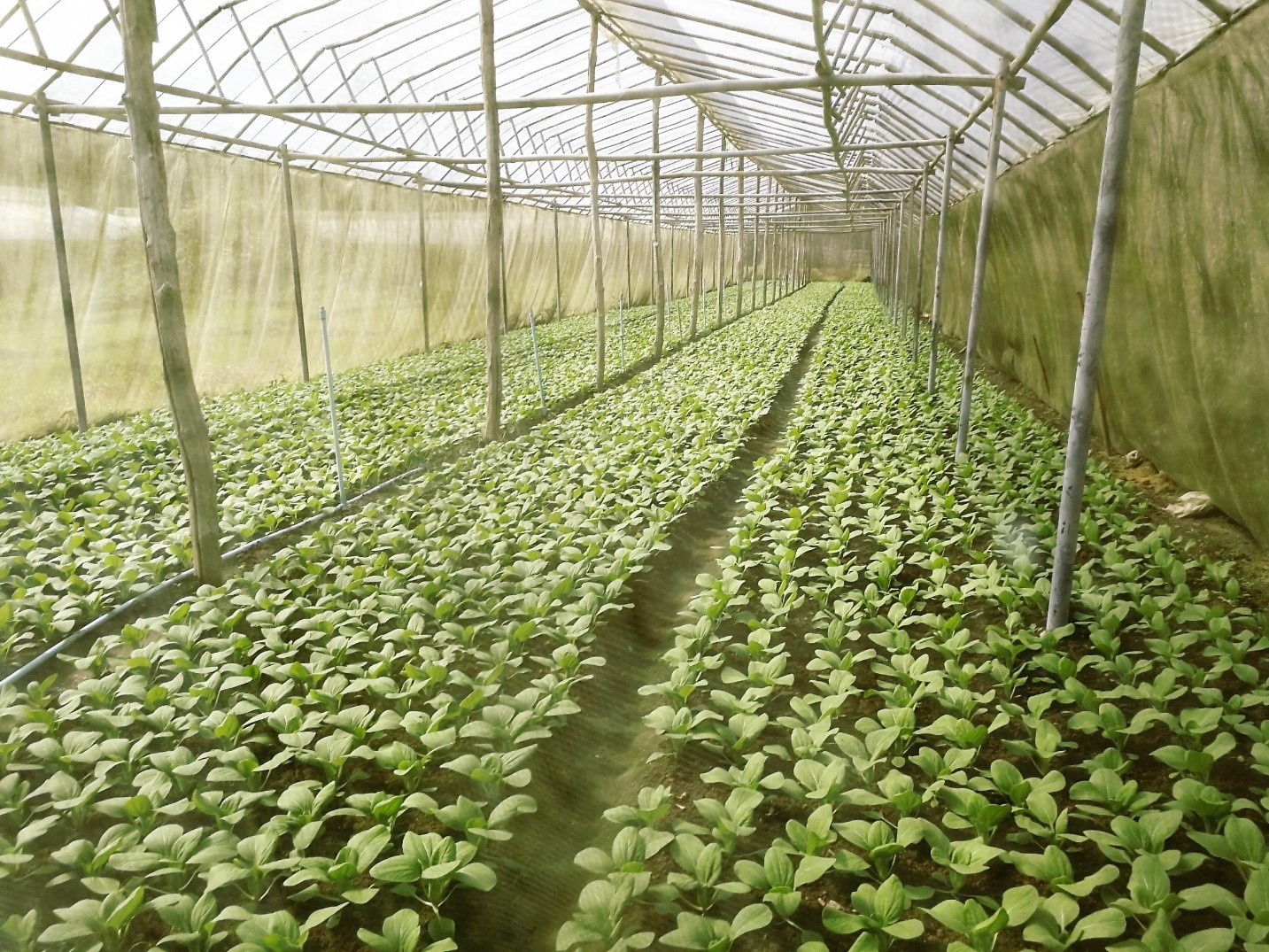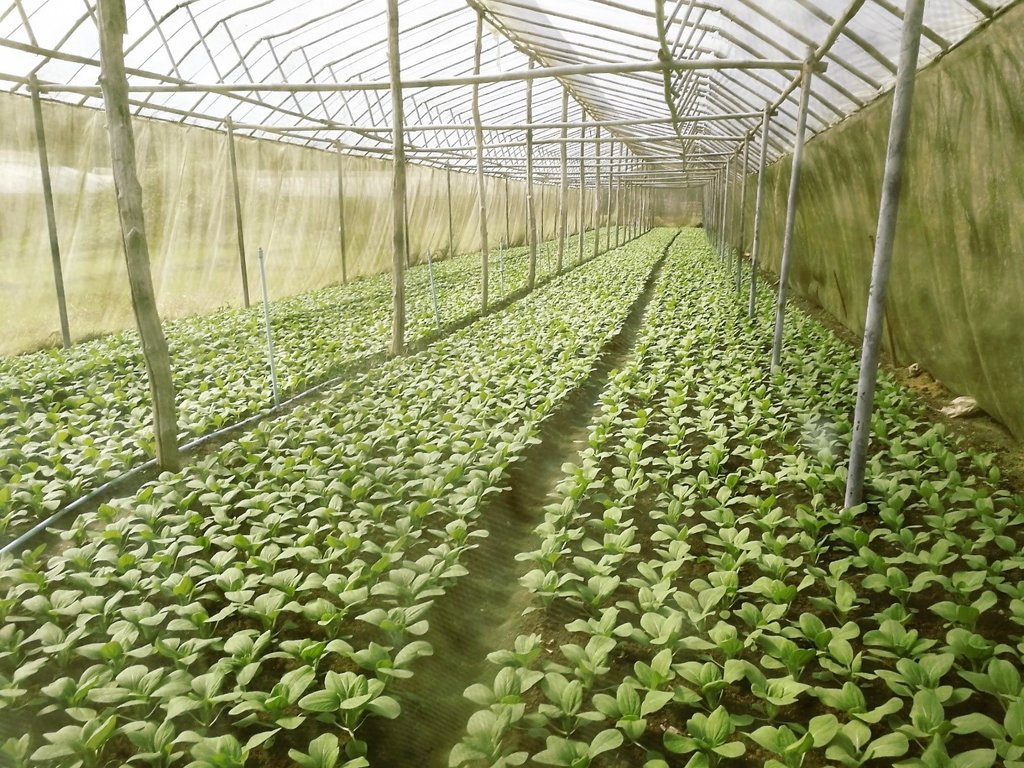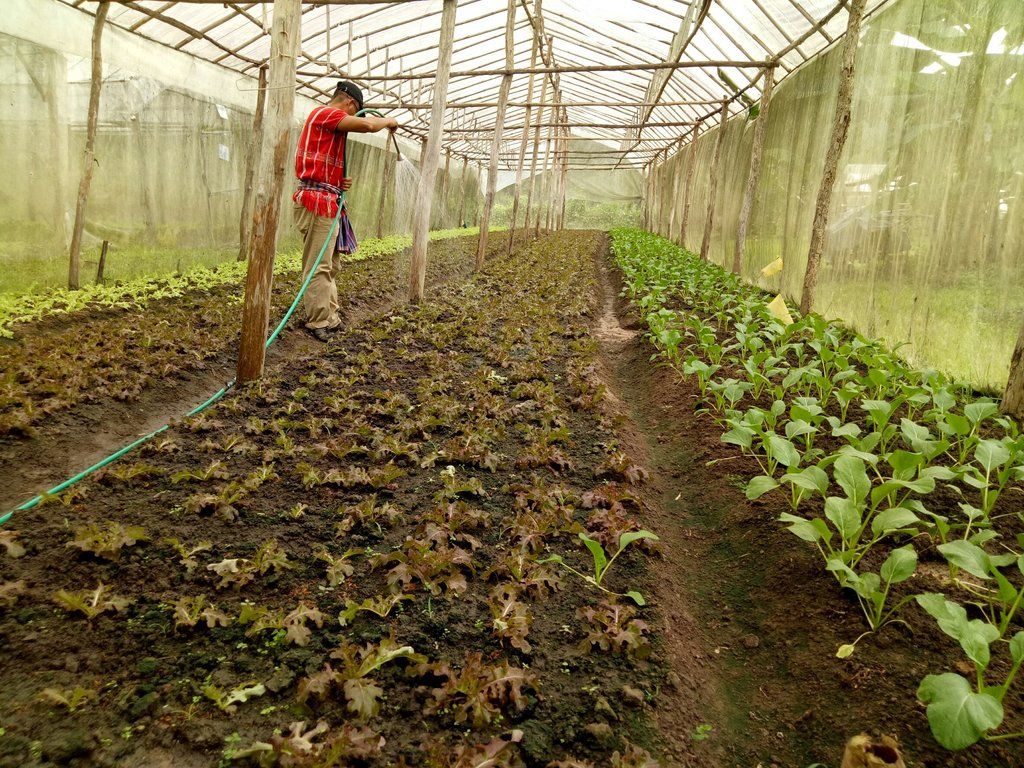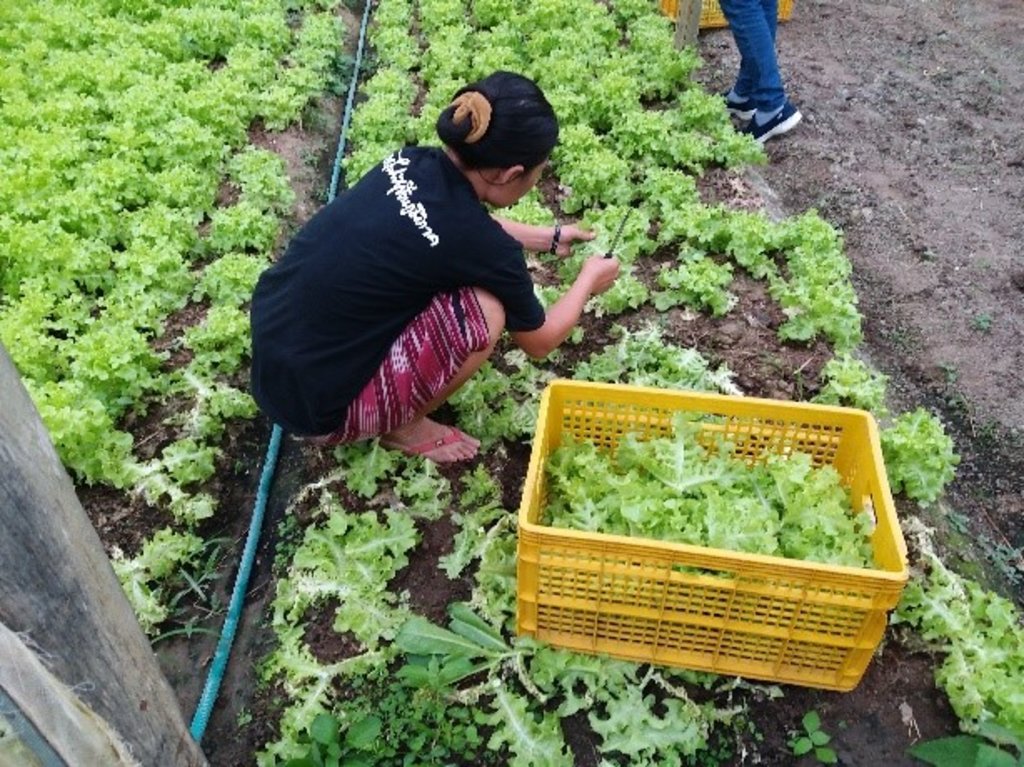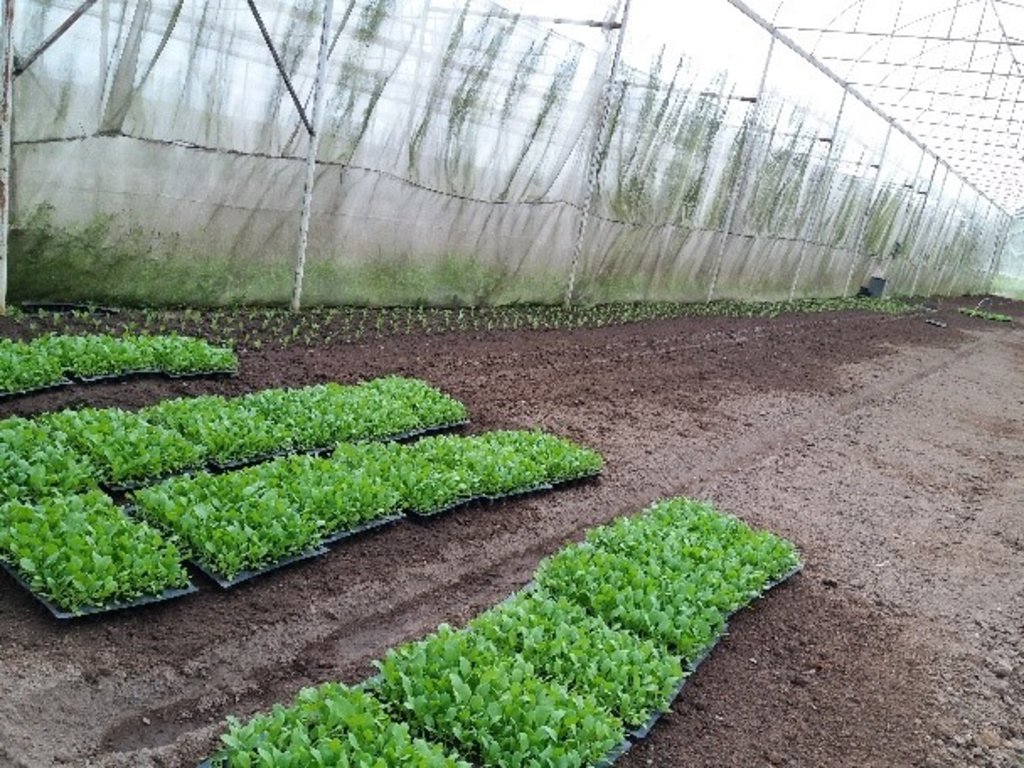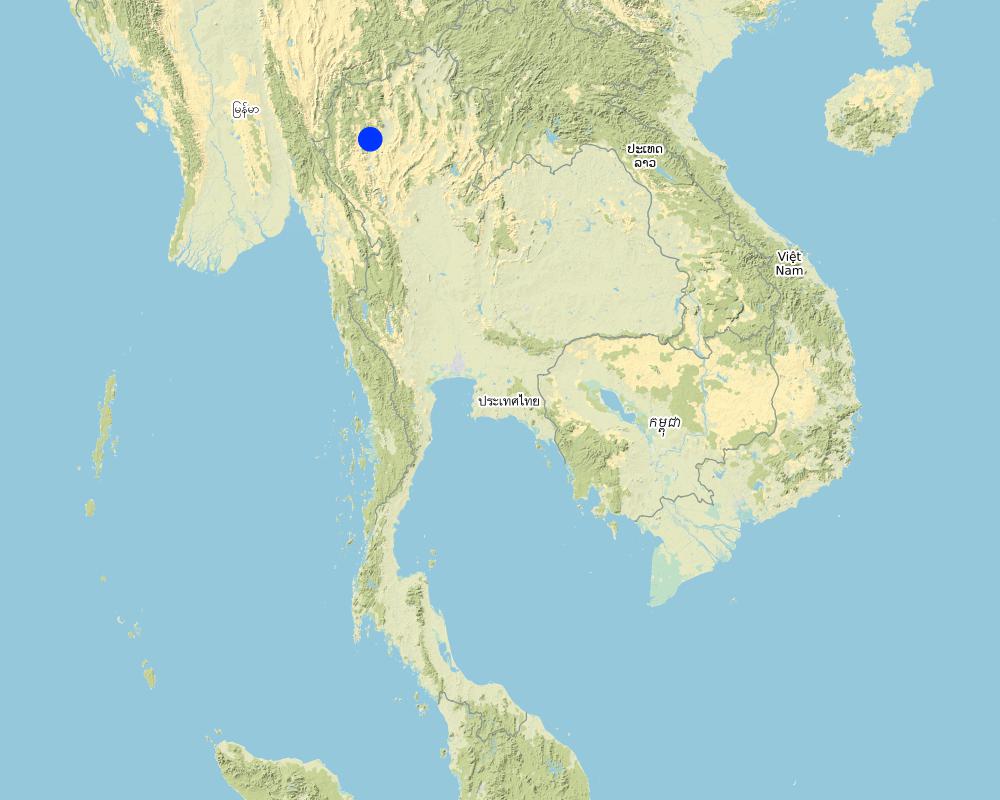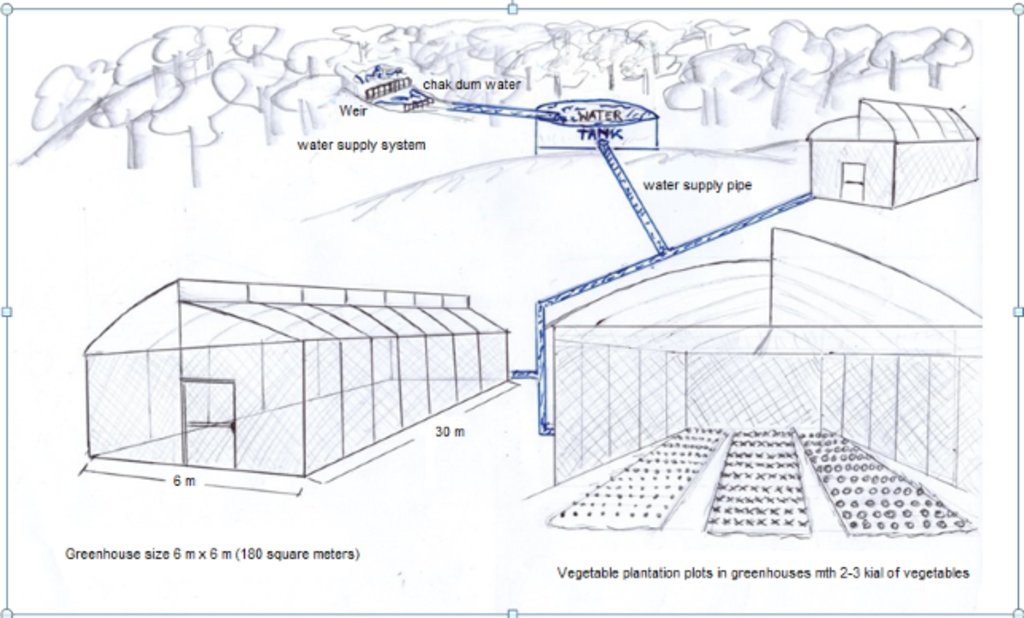Integrated Soil Management for Organic Vegetables on the Highland Watershed in the Northern Region [ໄທ]
- ການສ້າງ:
- ປັບປູງ:
- ຜູ້ສັງລວມຂໍ້ມູນ: Pitayakon Limtong
- ບັນນາທິການ: –
- ຜູ້ທົບທວນຄືນ: Rima Mekdaschi Studer, William Critchley
Organic vegetables in the Royal Project
technologies_4283 - ໄທ
ເບິ່ງພາກສ່ວນ
ຂະຫຍາຍທັງໝົດ ຍຸບທັງໝົດ1. ຂໍ້ມູນທົ່ວໄປ
1.2 ຂໍ້ມູນ ການຕິດຕໍ່ພົວພັນ ຂອງບຸກຄົນທີ່ສໍາຄັນ ແລະ ສະຖາບັນ ທີ່ມີສ່ວນຮ່ວມ ໃນການປະເມີນເອກກະສານ ເຕັກໂນໂລຢີ
ບັນດາຜູ້ຕອບແບບສອບຖາມທີ່ສໍາຄັນ ()
co-compiler:
Wattanaprapat Kamalapa
Land Development Department
ໄທ
ຜູ້ນໍາໃຊ້ທີ່ດິນ:
Phojanabandit Watcharin
Headman of village
ໄທ
local extension officer:
Kerephuwadon Boontre
Inthanon Royal Agricultural Station, the Royal Project
ໄທ
local LDD officer:
Intha Charun
Royal Project Land Development Center, Land Development Office Region 6, Land Development Department.
ໄທ
ຊື່ສະຖາບັນ (ຫຼາຍສະຖາບັນ) ທີ່ອໍານວຍຄວາມສະດວກ ໃນການສ້າງເອກກະສານ / ປະເມີນ ເຕັກໂນໂລຢີ (ຖ້າກ່ຽວຂ້ອງ)
Land Development Department LDD (Land Development Department LDD) - ໄທ1.3 ເງື່ອນໄຂ ກ່ຽວກັບ ການນໍາໃຊ້ຂໍ້ມູນເອກະສານ ທີ່ສ້າງຂື້ນ ໂດຍຜ່ານ ອົງການພາບລວມຂອງໂລກ ທາງດ້ານແນວທາງ ແລະ ເຕັກໂນໂລຢີ ຂອງການອານຸລັກ ທໍາມະຊາດ (WOCAT)
ຜູ້ປ້ອນຂໍ້ມູນ ແລະ ບຸກຄົນສຳຄັນ ທີ່ໃຫ້ຂໍ້ມູນ (ຫຼາຍ) ຍິນຍອມ ຕາມເງື່ອນໄຂ ໃນການນຳໃຊ້ຂໍ້ມູນ ເພື່ອສ້າງເປັນເອກກະສານຂອງ WOCAT:
ແມ່ນ
1.4 ແຈ້ງການວ່າ ດ້ວຍຄວາມຍືນຍົງຂອງ ເຕັກໂນໂລຢີ
ການນໍາໃຊ້ ເຕັກໂນໂລຢີ ດັ່ງກ່າວໄດ້ອະທິບາຍ ເຖິງບັນຫາ ກ່ຽວກັບ ການເຊື່ອມໂຊມຂອງດິນບໍ? ຖ້າບໍ່ດັ່ງນັ້ນ ມັນບໍ່ສາມາດ ຢັ້ງຢືນໄດ້ວ່າ ເປັນເຕັກໂນໂລຊີ ໃນການຄຸ້ມຄອງ ທີ່ດິນແບບຍືນຍົງ? :
ບໍ່ແມ່ນ
ຄວາມຄິດເຫັນ:
Organic vegetable production is a technology that prevents and restores land degradation due to soil management emphasized in using organic and natural materials to improve soil fertility and productivity, especially in terms of soil organic matter.
2. ການອະທິບາຍ ເຕັກໂນໂລຢີ ຂອງການຄຸ້ມຄອງ ທີ່ດິນແບບຍືນຍົງ
2.1 ຄໍາອະທິບາຍສັ້ນຂອງ ເຕັກໂນໂລຢີ
ການກຳໜົດຄວາມໝາຍ ຂອງເຕັກໂນໂລຢີ:
Organic vegetable cultivation on the highland area of the northern region of Thailand has been encouraged by local officers in order to produce safe food on degraded land through building up soil fertility and soil organic matter.
2.2 ການອະທິບາຍ ລາຍລະອຽດ ຂອງເຕັກໂນໂລຢີ
ການພັນລະນາ:
This case study is of organic vegetable cultivation at Ban Muang Ang Village which is located in Ban Luang Sub-district, Chom Thong District, Chiang Mai Province, covering approx. 25,881 Rai (6.25 rai = 1 ha; 625 rai = 1 sq km). The topography is a complex mountainous area within the Doi Inthanon National Park, at an elevation of 600-800 m asl. The climate is quite cool and humid with average temperature throughout the year being 20⁰C. The average annual rainfall is 2,000-2,100 mm. Most of the population belong to the Pakhayo hilltribe, living in 219 households, with total population of 588 persons (308 males, 280 females). The main purpose of promoting growing organic vegetables in greenhouses is to change their way of life from forest encroachment/ shifting cultivation in the upper watershed, to improving the ecosystem services and environment with better health and higher incomes for villagers.
Since 2002, the government and the Royal Project Foundation have had a policy to change land use to organic farming. At the early stage, yields of organic vegetables were not good. In the year 2010, the Inthanon Royal Agricultural Station brought a number of these land users to visit the Mae Tho Royal Project Development Center in Bo Sali Sub-district, Hot District, Chiang Mai Province. They obtained knowledge about organic cultivation in simple greenhouses made from bamboo poles, covered with plastic sheets and nylon nets. Local officers of the Inthanon Royal Agricultural Station supported with education, offered suggestions and recommended practices, as well as finding markets to sell the organic products; that became the model. It took only 25-30 days for a crop, and they could harvest about 200 kg of vegetables per greenhouse. They could produce 11 crops of vegetables in one year, which means that they could earn 10 times more income than before. At present, Muang Ang Village there are 153 members operating in 270 greenhouses which is the largest organic vegetable production area in the Inthanon Royal Project.
The production of organic vegetables in this area is outstanding. This network has received certification from the Department of Agriculture (DOA) and the Office of Organic Agriculture Certification Thailand (ACT Organic). Farmers or farming enterprises certified by this system are entitled to apply the logos and certification card of ACT Organic and IFOAM Accredited brand on their products. Moreover, the Agri-Food & Veterinary Authority of Singapore (AVA) has approved the production processes. Every production step has been approved through the standard regulation of each agency with tracking to the source of production inputs such as fertilizers, disease, weed and pest control measures, cultivation practices, etc. Now they have nine types of vegetables that constitute the main production: Choy, Baby Emperor, Cos Salad, Green Oak, Red Oak, Fille Iceberg, String Bean, Kale Hong Kong and Baby Carrot.
2.3 ຮູບພາບຂອງເຕັກໂນໂລຢີ
ຂໍ້ສັງເກດທົ່ວໄປທີ່ກ່ຽວກັບຮູບພາບ:
The simple nursery is 6 meters wide, 30 meters long, and 5 meters high. Organic vegetable seed is supported from the Royal Project with ready to planting into the plot.
2.4 ວິດີໂອ ເຕັກໂນໂລຢີ
ວັນທີ:
13/09/2018
ສະຖານທີ່:
Moo 9, Ban Mung Aung Village, Ban Luang Sub-district, Chom Thong District, Chiang Mai Province
ຊື່ຂອງຜູ້ຖ່າຍວີດີໂອ:
Ms. Kamalapa Wattanaprapat
2.5 ປະເທດ / ເຂດ / ສະຖານທີ່ບ່ອນທີ່ ເຕັກໂນໂລຢີ ໄດ້ຮັບການນໍາໃຊ້ ແລະ ທີ່ຖືກປົກຄຸມດ້ວຍການປະເມີນຜົນ
ປະເທດ:
ໄທ
ພາກພື້ນ / ລັດ / ແຂວງ:
Ban Luang Sub-district, Chom Thong District, Chiang Mai Province
ຂໍ້ມູນເພີ່ມເຕີມຂອງສະຖານທີ່:
Inthanon Royal Agricultural Station
ໃຫ້ລະບຸ ການແຜ່ຂະຫຍາຍ ເຕັກໂນໂລຢີ:
- ນໍາໃຊ້ໃນຈຸດສະເພາະ / ແນໃສ່ນໍາໃຊ້ໃນພື້ນທີ່ຂະໜາດນ້ອຍ
ຄວາມຄິດເຫັນ:
This activity is the integrated implementation project of the Royal Project in collaboration with other government agencies.
Map
×2.6 ວັນທີໃນການຈັດຕັ້ງປະຕິບັດ
ໃຫ້ລະບຸປີ ໃນການຈັດຕັ້ງປະຕິບັດ:
2002
ຖ້າຫາກວ່າ ບໍ່ຮູ້ຈັກ ປີທີ່ຊັດເຈນ ແມ່ນໃຫ້ປະມານ ວັນທີເອົາ:
- 10-50 ປີ ຜ່ານມາ
2.7 ການນໍາສະເໜີ ເຕັກໂນໂລຢີ
ໃຫ້ລະບຸ ເຕັກໂນໂລຢີ ໄດ້ຖືກຈັດຕັ້ງປະຕິບັດຄືແນວໃດ?
- ໂດຍຜ່ານໂຄງການ / ການຊ່ວຍເຫຼືອຈາກພາຍນອກ
ຄວາມຄິດເຫັນ (ປະເພດ ໂຄງການ ແລະ ອື່ນໆ):
All knowledge and technology is supported by the Royal Project collaboration with Land Development Department and other government and private agencies.
3. ການໃຈ້ແຍກ ເຕັກໂນໂລຢີ ໃນການຄຸ້ມຄອງ ດິນແບບຍືນຍົງ
3.1 ຈຸດປະສົງຫຼັກ (ຫຼາຍ) ຂອງເຕັກໂນໂລຢີ
- ການອະນຸລັກ ລະບົບນິເວດ
- ປົກປັກຮັກສາ / ການປັບປຸງຊີວະນາໆພັນ
- ສ້າງຜົນກະທົບ ທາງເສດຖະກິດ ທີ່ເປັນປະໂຫຍດ
3.2 ປະເພດການນໍາໃຊ້ທີ່ດິນ ໃນປະຈຸບັນ() ທີ່ເຕັກໂນໂລຢີ ໄດ້ຖືກນໍາໃຊ້

ດິນທີ່ປູກພືດ
- ການປູກພືດປະຈໍາປີ
ລະບຸ ຊະນິດ:
Vegetables: Cantonese, Baby Emperor, CosSalad, Oak leaf Green, Oak leaf Red, Guest Bean, Filler Iceberg, Kale Hong Kong and Baby Carrot.

ທິດທາງໄຫຼຂອງນໍ້າ, ນໍ້າ, ດິນທາມ
ຜະລິດຕະພັນຫຼັກ / ບໍລິການ:
Irrigation water from a storage tank at the upper part, through PVC pipes to the area cultivated to the organic vegetables.
ຄວາມຄິດເຫັນ:
In the past, villagers had encroached on forest areas and deforestation in highland for shifting cultivation, and also expand cultivation area into steep slope. Resulting in the destruction of forest areas and accelerated soil degradation. Villagers have low incomes: not enough to survive. But due to the grace of His Majesty King Bhumibol Adulyadej, King Rama 9 set up the Royal Project to distribute knowledge and education to all farmers in this area, and assist them to have better occupation and living standards.
3.3 ການນຳໃຊ້ທີ່ດິນ ມີການປ່ຽນແປງຍ້ອນການຈັດຕັ້ງທົດລອງເຕັກໂນໂລຢີ ແມ່ນບໍ່?
ຄວາມຄິດເຫັນ:
The Royal Project has promoted the production of organic vegetables. Farmers therefore have changed from shifting cultivation to organic agriculture with sustainable soil management. As well as returning from forest areas and conserving soil, water and forest resources, maintaining ecological balance, this all makes villagers lives better. According to the cultivation schedule provided by the Royal Project, this area can cultivated throughout the year due to the development of irrigation systems from the storage tank in the upper part and supply to each plot of this targeted area.
3.4 ການສະໜອງນ້ຳ
ອື່ນໆ (ຕົວຢ່າງ, ຫຼັງຈາກນໍ້າຖ້ວມ):
- water from watershed area
ຄວາມຄິດເຫັນ:
Water resources are obtained from watercourses in the watershed, with a small dam which collects water in a reservoir. A PVC pipe is connected from the reservoir to individual plots and this irrigation system allows allocation to every farmer by the water management group.
3.5 ການນໍາໃຊ້ເຕັກໂນໂລຢີ ທີ່ຢູ່ໃນກຸ່ມການຄຸ້ມຄອງ ທີ່ດິນແບບຍືນຍົງ
- ລະບົບການປູກພືດໝູນວຽນ (ການປູກພືດໝູນວຽນ, ປ່າເລົ່າ, ການຖາງປ່າເຮັດໄຮ່)
- ການຈັດການຄຸ້ມຄອງພະຍາດ ແລະ ສັດຕູພືດ ແບບປະສົມປະສານ (ລວມທັງກະສິກຳອິນຊີ)
- ການຄຸ້ມຄອງຊົນລະປະທານ (ການສະໜອງນໍ້າ, ລະບາຍ)
3.6 ມາດຕະການ ການຄຸ້ມຄອງ ທີ່ດິນແບບຍືນຍົງ ປະກອບດ້ວຍ ເຕັກໂນໂລຢີ

ມາດຕະການ ທາງການກະສິກໍາ
- A2: ອິນຊີວັດຖຸ ຫຼື ຄວາມອຸດົມສົມບູນໃນດິນ

ມາດຕະການ ທາງດ້ານການຄຸ້ມຄອງ
- M2: ການປ່ຽນແປງ ການຈັດການຄຸ້ມຄອງ / ລະດັບຄວາມໜາແໜ້ນ
ຄວາມຄິດເຫັນ:
-
3.7 ປະເພດດິນເຊື່ອມໂຊມ ຫຼັກທີ່ໄດ້ນໍາໃຊ້ ເຕັກໂນໂລຢີ

ດິນເຊາະເຈື່ອນ ໂດຍນໍ້າ
- Wt: ການສູນເສຍຊັ້ນໜ້າດິນ / ການເຊາະເຈື່ອນຜິວໜ້າດິນ

ການເຊື່ອມໂຊມ ຂອງດິນ ທາງເຄມີ
- Cp: ດິນເປັນມົນລະພິດ

ການເຊື່ອມໂຊມ ທາງຊີວະພາບ
- Bl: ການສູນເສຍ ຈຸລິນຊີໃນດິນ
- Bp: ສັດຕູພືດ ແລະ ພະຍາດເພີ່ມຂື້ນ, ສູນເສຍນັກລ່າ ແມງໄມ້ທີ່ໃຊ້ປາບສັດຕູພືດ ແລະ ພະຍາດຂອງພືດ
ຄວາມຄິດເຫັນ:
Organic vegetable production in greenhouses can solve the problem of soil erosion with utilization of compost, animal and green manure to increase fertility and organic matter.
3.8 ການປ້ອງກັນ, ການຫຼຸດຜ່ອນ, ຫຼືການຟື້ນຟູຂອງການເຊື່ອມໂຊມຂອງດິນ
ໃຫ້ລະບຸ ເປົ້າໝາຍ ເຕັກໂນໂລຢີ ທີ່ພົວພັນ ກັບຄວາມເຊື່ອມໂຊມຂອງດິນ:
- ປ້ອງກັນການເຊື່ອມໂຊມຂອງດິນ
- ຫຼຸດຜ່ອນການເຊື່ອມໂຊມຂອງດິນ
ຄວາມຄິດເຫັນ:
This organic vegetable production on very steep land can prevent and reduce soil erosion. Moreover, organic material and fertilizers can restore and improve soil fertility and productivity.
4. ຂໍ້ກໍາໜົດ, ກິດຈະກໍາການປະຕິບັດ, ວັດຖຸດິບ, ແລະຄ່າໃຊ້ຈ່າຍ
4.1 ເຕັກນິກ ໃນການແຕ້ມແຜນວາດ ເຕັກໂນໂລຢີ
ຄຸນລັກສະນະ ຂອງເຕັກນິກ (ທີ່ກ່ຽວຂ້ອງ ກັບການແຕ້ມແຜນວາດ ທາງດ້ານເຕັກນີກ):
Operating procedures
1. Establishment of networks: All land users set up networks of organic vegetable producers and register the members properly; all members must act strictly according to the regulations.
2. Integrated cooperation: The Inthanon Royal Agricultural Station and the Inthanon Highland Agricultural Extension Center organize training on organic farming at least once a year, including study trip/s to visit other successful organic farmers.
3. Selection of the area: Leaders and members select the area for members, each member occupying not more than three greenhouses, 6m wide, 30m long and 3-5m high (180 sq m).
4. Production planning: land users discuss with the staff of the Inthanon Royal Agricultural Station, and plan the production schedule and types of vegetables to meet the market demand.
5. Procurement of production inputs: Both of local officers with inspectors and farmers can buy production inputs by themselves. All materials must be organic and are from reliable sources. Farmers must be very careful in this matter.
6. Organic vegetables cultivation: All land users must strictly comply with the schedule of cultivation, practices in soil improvement, control of pests and diseases, plus recording every step of their activities.
7. Production monitoring: Staffs of the Inthanon Royal Agricultural Station and Department of Agricultural Extension (DOAE) monitor and observe land users’ practices in using soil improvement methods and using bioproducts for controlling insects, predators, parasites and diseases. Department of Agriculture (DOA) and the Organic Agriculture Certification Thailand (ACT Organic) monitor the production process.
8. Harvesting of Products: All land users must harvest according to the harvesting schedule and the preservation methods. DOA and ACT Organic serve as certification agencies by analyzing the contamination of substances in the products.
9. Screening and packing: All land users must clean their products with non-contaminated equipment, and also screen the quality and specified size/s of products for delivery to the Inthanon Royal Agricultural Station.
ຜູ້ຂຽນ:
Ms.Kamalapa Watanaprapat
ວັນທີ:
25/10/2018
4.2 ຂໍ້ມູນທົ່ວໄປກ່ຽວກັບການຄິດໄລ່ປັດໃຈຂາເຂົ້າໃນການຜະລິດ ແລະ ມູນຄ່າອື່ນໆ
ລະບຸ ວິທີການ ຄຳໃຊ້ຈ່າຍ ແລະ ປັດໄຈນໍາເຂົ້າ ທີ່ໄດ້ຄິດໄລ່:
- ຕໍ່ພື້ນທີ່ ທີ່ໄດ້ຈັດຕັ້ງປະຕິບັດ ເຕັກໂນໂລຢີ
ໃຫ້ລະບຸຫົວໜ່ວຍ ຂະໜາດ ແລະ ເນື້ອທີ່:
70 rai
ຖ້ານໍາໃຊ້ຫົວໜ່ວຍ ເນື້ອທີ່ຕາມທ້ອງຖິ່ນ, ໃຫ້ປ່ຽບເປັນ 1 ເຮັກຕາ (ຕົວຢ່າງ: 1 ເຮັກຕາ = 4 ໄລ່ ): 1 ເຮັກຕາ = :
1 ha = 6.25 rai
ສະກຸນເງິນອື່ນໆ / ປະເທດອື່ນໆ (ລະບຸ):
Baht (THB)
ຖ້າກ່ຽວຂ້ອງ, ໃຫ້ລະບຸອັດຕາແລກປ່ຽນຈາກ USD ເປັນສະກຸນເງິນທ້ອງຖິ່ນ (ເຊັ່ນ: 1 USD = 79.9 Brazilian Real): 1 USD =:
32.0
ລະບຸ ຄ່າຈ້າງ ຄ່າແຮງງານສະເລ່ຍ ຕໍ່ ວັນ:
300
4.3 ການສ້າງຕັ້ງກິດຈະກໍາ
| ກິດຈະກໍາ | Timing (season) | |
|---|---|---|
| 1. | Establish organic vegetables group | The first year of cultivation |
| 2. | Site selection | Before cultivation |
| 3. | Construct greenhouse or nursery | Before cultivation |
| 4. | Production work plan | Before cultivation |
| 5. | Procurement of production factors | Before cultivation |
| 6. | Soil preparation and improvement | During soil preparation |
| 7. | Vegetables seedling preparation | During soil preparation |
| 8. | Plantation | During vegetables planting |
| 9. | Disease and pest control | During vegetables planting |
| 10. | Vegetable harvesting | During harvesting |
| 11. | Screening and packing | After harvesting |
| 12. | Technology maintenance | After harvesting |
ຄວາມຄິດເຫັນ:
-
4.4 ຕົ້ນທຶນ ແລະ ປັດໄຈຂາເຂົ້າທີ່ຈໍາເປັນໃນຈັດຕັ້ງປະຕິບັດ
| ລະບຸ ປັດໃຈ ນໍາເຂົ້າ ໃນການຜະລີດ | ຫົວໜ່ວຍ | ປະລິມານ | ຕົ້ນທຶນ ຕໍ່ຫົວໜ່ວຍ | ຕົ້ນທຶນທັງໝົດ ຂອງປັດໃຈຂາເຂົ້າ ໃນການຜະລິດ | % ຂອງຕົ້ນທຶນທັງໝົດ ທີ່ຜູ້ນໍາໃຊ້ທີ່ດິນ ໃຊ້ຈ່າຍເອງ | |
|---|---|---|---|---|---|---|
| ແຮງງານ | Construct greenhouse | man | 10.0 | 300.0 | 3000.0 | 100.0 |
| ແຮງງານ | During cultivation | man | 6.0 | 300.0 | 1800.0 | 100.0 |
| ແຮງງານ | During maintenance | man | 45.0 | 300.0 | 13500.0 | 100.0 |
| ແຮງງານ | During harvesting | man | 10.0 | 300.0 | 3000.0 | 100.0 |
| ອຸປະກອນ | Rubber pipe | piece | 1.0 | 1000.0 | 1000.0 | 100.0 |
| ອຸປະກອນ | Tractor for soil preparation | Rai | 1.0 | 300.0 | 300.0 | 100.0 |
| ວັດສະດຸໃນການປູກ | Vegetables seed | site | 1.0 | 700.0 | 700.0 | 100.0 |
| ຝຸ່ນ ແລະ ຢາຊີວະພາບ | Animal manure (cow manure) | bag | 20.0 | 30.0 | 600.0 | 100.0 |
| ຝຸ່ນ ແລະ ຢາຊີວະພາບ | BT bio-product | litre | 100.0 | |||
| ຝຸ່ນ ແລະ ຢາຊີວະພາບ | Predators and parasites | - | ||||
| ຝຸ່ນ ແລະ ຢາຊີວະພາບ | Insect glue trap | liter | 0.5 | 290.0 | 145.0 | 100.0 |
| ຝຸ່ນ ແລະ ຢາຊີວະພາບ | Yellow plastic plate | piece | 60.0 | 5.0 | 300.0 | 100.0 |
| ຝຸ່ນ ແລະ ຢາຊີວະພາບ | Yellow plastic bag | litre | 0.5 | 120.0 | 60.0 | 100.0 |
| ວັດສະດຸກໍ່ສ້າງ | Wood frame / mesh net / plastic cloth | site | 1.0 | 14700.0 | 14700.0 | 40.0 |
| ວັດສະດຸກໍ່ສ້າງ | PVC pipe | piece | 40.0 | 40.0 | 1600.0 | 100.0 |
| ຕົ້ນທຶນທັງໝົດ ໃນການຈັດຕັ້ງປະຕິບັດ ເຕັກໂນໂລຢີ | 40705.0 | |||||
| ຄ່າໃຊ້ຈ່າຍທັງໝົດ ສຳລັບການສ້າງຕັ້ງເຕັກໂນໂລຢີ ເປັນສະກຸນເງີນໂດລາ | 1272.03 | |||||
ຖ້າຫາກຜູ້ນຳໃຊ້ທີ່ດິນ ນຳໃຊ້ມູນຄ່າຕ່ຳກວ່າ 100% ໃຫ້ລະບຸ ແມ່ນໃຜເປັນຜູ້ຊ່ວຍ ໃນລາຍຈ່າຍທີ່ເຫຼືອ:
Construction greenhouse cost, land users support 40%, and Organic Vegetable Production Fund support 60% of this cost.
ຄວາມຄິດເຫັນ:
Labor cost in greenhouse construction, greenhouse materials, which land users would only pay for the first year, but they do not pay for the second year and do not much towards repair cost.
4.5 ບໍາລຸງຮັກສາ / ແຜນຈັດຕັ້ງປະຕິບັດ ກິດຈະກໍາ
| ກິດຈະກໍາ | ໄລຍະເວລາ / ຄວາມຖີ່ | |
|---|---|---|
| 1. | Changing the plastic sheet of the roof of greenhouse | 3,000 baht per greenhouse every 3 years |
| 2. | Washing the plastic sheet of the greenhouse roof | Once a year |
ຄວາມຄິດເຫັນ:
-
4.6 ຄ່າໃຊ້ຈ່າຍ ແລະ ປັດໄຈນໍາເຂົ້າທີ່ຈໍາເປັນສໍາລັບການບໍາລຸງຮັກສາກິດຈະກໍາ / ແຜນປະຕິບັດ (ຕໍ່ປີ)
| ລະບຸ ປັດໃຈ ນໍາເຂົ້າ ໃນການຜະລີດ | ຫົວໜ່ວຍ | ປະລິມານ | ຕົ້ນທຶນ ຕໍ່ຫົວໜ່ວຍ | ຕົ້ນທຶນທັງໝົດ ຂອງປັດໃຈຂາເຂົ້າ ໃນການຜະລິດ | % ຂອງຕົ້ນທຶນທັງໝົດ ທີ່ຜູ້ນໍາໃຊ້ທີ່ດິນ ໃຊ້ຈ່າຍເອງ | |
|---|---|---|---|---|---|---|
| ແຮງງານ | Changing plastic sheets | man | 3.0 | 300.0 | 900.0 | 100.0 |
| ແຮງງານ | Wash plastic sheets | man | 3.0 | 300.0 | 900.0 | 100.0 |
| ວັດສະດຸກໍ່ສ້າງ | Plastic sheet (change every 3 years) | roll | 1.0 | 3700.0 | 3700.0 | 100.0 |
| ຕົ້ນທຶນທັງໝົດ ທີ່ໃຊ້ໃນການບໍາລຸງຮັກສາ ເຕັກໂນໂລຢີ | 5500.0 | |||||
| ຄ່າໃຊ້ຈ່າຍທັງໝົດ ສຳລັບການບົວລະບັດຮກສາເຕັກໂນໂລຢີ ເປັນສະກຸນເງີນໂດລາ | 171.88 | |||||
ຖ້າຫາກຜູ້ນຳໃຊ້ທີ່ດິນ ນຳໃຊ້ມູນຄ່າຕ່ຳກວ່າ 100% ໃຫ້ລະບຸ ແມ່ນໃຜເປັນຜູ້ຊ່ວຍ ໃນລາຍຈ່າຍທີ່ເຫຼືອ:
Land users purchase 100%
ຄວາມຄິດເຫັນ:
Land users purchase 100%
4.7 ປັດໄຈ ທີ່ສໍາຄັນ ທີ່ສົ່ງຜົນກະທົບ ຕໍ່ຄ່າໃຊ້ຈ່າຍ
ໃຫ້ອະທິບາຍ ປັດໃຈ ທີ່ສົ່ງຜົນກະທົບ ຕໍ່ຕົ້ນທຶນ ໃນການຈັດຕັ້ງປະຕິບັດ:
The most important factor that affects other costs is seed. Manure must be purchased from standard organic source. The Royal Project provides standard seed, and animal manure must be purchased from other provinces that require natural cultivation farming. The source of the materials used can be traced back to the original provider. Labor factors are not impacted because they can help each other, and land users work together in each greenhouse.
5. ສະພາບແວດລ້ອມທໍາມະຊາດ ແລະ ມະນຸດ
5.1 ອາກາດ
ປະລິມານນໍ້າຝົນປະຈໍາປີ
- < 250 ມີລິແມັດ
- 251-500 ມີລິແມັດ
- 501-750 ມີລິແມັດ
- 751-1,000 ມີລິແມັດ
- 1,001-1,500 ມີລິແມັດ
- 1,501-2,000 ມີລິແມັດ
- 2,001-3,000 ມີລິແມັດ
- 3,001-4,000 ມີລິແມັດ
- > 4,000 ມີລິແມັດ
ໃຫ້ລະບຸສະເລ່ຍ ປະລິມານນໍ້າຝົນຕົກປະຈໍາປີ ເປັນມິນລິແມັດ (ຖ້າຫາກຮູ້ຈັກ):
1500.00
ຂໍ້ມູນສະເພາະ / ຄວາມເຫັນກ່ຽວກັບ ປະລິມານນໍ້າຝົນ:
Rainy season is from June - October
ໃຫ້ລະບຸ ຊື່ສະຖານີ ອຸຕຸນິຍົມ ເພື່ອເປັນຂໍ້ມູນອ້າງອີງ:
Inthanon Royal Project Meteorological Station
ເຂດສະພາບອາກາດກະສິກໍາ
- ເຄີ່ງຄວາມຊຸ່ມ
-
5.2 ພູມິປະເທດ
ຄ່າສະເລ່ຍ ຄວາມຄ້ອຍຊັນ:
- ພື້ນທີ່ຮາບພຽງ (0-2%)
- ອ່ອນ (3-5 %)
- ປານກາງ (6-10 %)
- ມ້ວນ (11-15 %)
- ເນີນ(16-30%)
- ໍຊັນ (31-60%)
- ຊັນຫຼາຍ (>60%)
ຮູບແບບຂອງດິນ:
- ພູພຽງ / ທົ່ງພຽງ
- ສັນພູ
- ເປີ້ນພູ
- ເນີນພູ
- ຕີນພູ
- ຮ່ອມພູ
ເຂດລະດັບສູງ:
- 0-100 ແມັດ a.s.l.
- 101-500 ແມັດ a.s.l.
- 501-1,000 ແມັດ a.s.l.
- 1,001-1,500 ແມັດ a.s.l.
- 1,501-2,000 ແມັດ a.s.l.
- 2,001-2,500 ແມັດ a.s.l.
- 2,501-3,000 ແມັດ a.s.l.
- 3,001-4,000 ແມັດ a.s.l.
- > 4,000 ແມັດ a.s.l.
ໃຫ້ລະບຸ ເຕັກໂນໂລຢີ ທີ່ໄດ້ຖືກນຳໃຊ້:
- ລັກສະນະສວດ
ຄຳເຫັນ ແລະ ຂໍ້ມູນສະເພາະ ເພີ່ມເຕີມ ກ່ຽວກັບ ພູມີປະເທດ:
Most of the area is mountainous slope complex, with a steep slope and attitude is 1,200-1,400 meters above sea level. The forest condition is good, and some areas of the Doi Inthanon is national park and some is in national forest reserve.
5.3 ດິນ
ຄວາມເລິກ ຂອງດິນສະເລ່ຍ:
- ຕື້ນຫຼາຍ (0-20 ຊັງຕີແມັດ)
- ຕື້ນ (21-50 ຊຕມ)
- ເລີກປານກາງ (51-80 ຊຕມ)
- ເລິກ (81-120 ຊມ)
- ເລິກຫຼາຍ (> 120 cm)
ເນື້ອດິນ (ໜ້າດິນ):
- ປານກາງ (ດິນໜຽວ, ດິນໂຄນ)
ເນື້ອດິນ (ເລິກຈາກໜ້າດິນ ລົງໄປຫຼາຍກວ່າ 20 ຊັງຕິແມັດ):
- ຫຍາບ / ເບົາ (ດິນຊາຍ)
ຊັ້ນອິນຊີວັດຖຸ ເທິງໜ້າດິນ:
- ປານກາງ (1-3 %)
ຖ້າເປັນໄປໄດ້ ແມ່ນໃຫ້ຕິດຄັດ ການພັນລະນາດິນ ຫຼື ຂໍ້ມູນສະເພາະຂອງດິນ, ຕົວຢ່າງ, ຄຸນລັກສະນະ ປະເພດຂອງດິນ, ຄ່າຄວາມເປັນກົດ / ເປັນດ່າງຂອງດິນ, ສານອາຫານ, ດິນເຄັມ ແລະ ອື່ນໆ.
Soil pH is 5.5-6.0
5.4 ມີນໍ້າ ແລະ ຄຸນນະພາບ
ລະດັບ ນໍ້າໃຕ້ດິນ:
> 50 ແມັດ
ການມີນໍ້າ ເທິງໜ້າດິນ:
ດີ
ຄຸນນະພາບນໍ້າ (ບໍ່ມີການບໍາບັດ):
ນຳໃຊ້ເຂົ້າໃນການຜະລິດກະສິກໍາພຽງຢ່າງດຽງ (ຊົນລະປະທານ)
ມີບັນຫາ ກ່ຽວກັບນໍ້າເຄັມບໍ່?
ບໍ່ແມ່ນ
ເກີດມີນໍ້າຖ້ວມ ໃນພື້ນທີ່ບໍ່?
ບໍ່ແມ່ນ
ຄວາມຄິດເຫັນ ແລະ ຂໍ້ກໍານົດ ເພີ່ມເຕີມ ກ່ຽວກັບ ຄຸນນະພາບ ແລະ ປະລິມານ ຂອງນ້ຳ:
Water flows from the watershed area of the upper forest, and not flow through the conventional agricultural area.
5.5 ຊີວະນາໆພັນ
ຄວາມຫຼາກຫຼາຍ ທາງສາຍພັນ:
- ປານກາງ
ຄວາມຫຼາກຫຼາຍ ທາງດ້ານ ທີ່ຢູ່ອາໃສ ຂອງສິ່ງທີ່ມີຊີວິດ:
- ປານກາງ
ຄວາມຄິດເຫັນ ແລະ ລັກສະນະສະເພາະ ເພີ່ມເຕີມກ່ຽວກັບ ຊີວະນາໆພັນ:
Biodiversity in this area has a variety of insects. There are both pests and predators.
5.6 ຄຸນລັກສະນະ ຂອງຜູ້ນໍາໃຊ້ທີ່ດິນ ທີ່ໄດ້ນໍາໃຊ້ເຕັກໂນໂລຢີ
ຢູ່ປະຈຳ ຫຼື ເຄື່ອນຍ້າຍຕະຫຼອດ:
- ບໍ່ເຄື່ອນໄຫວ
ລະບົບ ການຕະຫຼາດ ແລະ ຜົນຜະລິດ:
- ປະສົມປົນເປ( ກຸ້ມຕົນເອງ/ເປັນສິນຄ້າ)
ລາຍຮັບ ທີ່ບໍ່ໄດ້ມາຈາກ ການຜະລິດ ກະສິກໍາ:
- 10-50 % ຂອງລາຍຮັບທັງໝົດ
ລະດັບຄວາມຮັ່ງມີ:
- ສະເລ່ຍ
ບຸກຄົນ ຫຼື ກຸ່ມ:
- ກຸ່ມ / ຊຸມຊົນ
ລະດັບ ການຫັນເປັນກົນຈັກ:
- ການໃຊ້ແຮງງານຄົນ
ເພດ:
- ຜູ້ຍິງ
- ຜູ້ຊາຍ
ອາຍຸ ຂອງຜູ້ນໍາໃຊ້ທີ່ດິນ:
- ຊາວໜຸ່ມ
- ໄວກາງຄົນ
- ຜູ້ສູງອາຍຸ
ໃຫ້ລະບຸ ຄຸນລັກສະນະ ຂອງຜູ້ນໍາໃຊ້ທີ່ດິນ:
Land users can cultivate organic vegetables and earning more income, where young generation in the village become interested and help their families to cultivate organic vegetables. Moreover these young generation who have graduated from university like to become farmers and do not leave to other occupations.
5.7 ເນື້ອທີ່ສະເລ່ຍຂອງດິນ ທີ່ຜູ້ນຳໃຊ້ທີ່ດິນ ໃຊ້ເຮັດເຕັກໂນໂລຢີ
- <0.5 ເຮັກຕາ
- 0.5-1 ເຮັກຕາ
- 1-2 ເຮັກຕາ
- 2-5 ເຮັກຕາ
- 5-15 ເຮັກຕາ
- 15-50 ເຮັກຕາ
- 50-100 ເຮັກຕາ
- 100-500 ເຮັກຕາ
- 500-1,000 ເຮັກຕາ
- 1,000-10,000 ເຮັກຕາ
- > 10,000 ເຮັກຕາ
ຖືໄດ້ວ່າ ເປັນຂະໜາດນ້ອຍ, ກາງ ຫຼື ໃຫຍ່ (ອີງຕາມເງື່ອນໄຂ ສະພາບຄວາມເປັນຈິງ ຂອງທ້ອງຖີ່ນ)? :
- ຂະໜາດກາງ
ຄວາມຄິດເຫັນ:
Most land users have an average land of 20 rai, consisting of 3-5 rai for rice fields, and 10-15 rai of rotation cultivation. They do not have right in landownership because all of these land are in the reserved forest area and national park. But they have right in utilize their land under the Royal Project.
5.8 ເຈົ້າຂອງທີ່ດິນ, ສິດໃຊ້ທີ່ດິນ, ແລະ ສິດທິການນໍາໃຊ້ນໍ້າ
ເຈົ້າຂອງດິນ:
- ບຸກຄົນ, ບໍ່ມີຕໍາແໜ່ງ
ສິດທິ ໃນການນໍາໃຊ້ທີ່ດິນ:
- ຊຸມຊົນ (ທີ່ມີການຈັດຕັ້ງ)
ສິດທິ ໃນການນໍາໃຊ້ນໍ້າ:
- ຊຸມຊົນ (ທີ່ມີການຈັດຕັ້ງ)
ລະບຸ ຊະນິດ:
-
ຄວາມຄິດເຫັນ:
Land users in this area are Lawa hill tribe who migrated from different places to settle here. The main occupation is agriculture under crop rotation, some harvesting of forest products, and some animals. They have not right in landownership but they have right to utilize their land and water for agricultural activities under the Royal Project.
5.9 ການເຂົ້າເຖິງການບໍລິການ ແລະ ພື້ນຖານໂຄງລ່າງ
ສຸຂະພາບ:
- ທຸກຍາກ
- ປານກາງ
- ດີ
ການສຶກສາ:
- ທຸກຍາກ
- ປານກາງ
- ດີ
ການຊ່ວຍເຫຼືອ ດ້ານວິຊາການ:
- ທຸກຍາກ
- ປານກາງ
- ດີ
ການຈ້າງງານ (ຕົວຢ່າງ, ການເຮັດກິດຈະກໍາອື່ນ ທີ່ບໍ່ແມ່ນ ການຜະລິດກະສິກໍາ):
- ທຸກຍາກ
- ປານກາງ
- ດີ
ຕະຫຼາດ:
- ທຸກຍາກ
- ປານກາງ
- ດີ
ພະລັງງານ:
- ທຸກຍາກ
- ປານກາງ
- ດີ
ຖະໜົນຫົນທາງ ແລະ ການຂົນສົ່ງ:
- ທຸກຍາກ
- ປານກາງ
- ດີ
ການດື່ມນໍ້າ ແລະ ສຸຂາພິບານ:
- ທຸກຍາກ
- ປານກາງ
- ດີ
ການບໍລິການ ທາງດ້ານການເງິນ:
- ທຸກຍາກ
- ປານກາງ
- ດີ
Average debt 20,000 baht per person:
- ທຸກຍາກ
- ປານກາງ
- ດີ
ຄວາມຄິດເຫັນ:
-
6. ຜົນກະທົບ ແລະ ລາຍງານສະຫຼຸບ
6.1 ການສະແດງຜົນກະທົບ ພາຍໃນພື້ນທີ່ ທີ່ໄດ້ຈັດຕັ້ງປະຕິບັດ ເຕັກໂນໂລຢີ
ຜົນກະທົບທາງເສດຖະກິດສັງຄົມ
ການຜະລິດ
ການຜະລິດພືດ
ຄວາມຄິດເຫັນ / ລະບຸແຈ້ງ:
Land users can cultivate 11 times per year.
ຄຸນນະພາບຂອງພືດ
ຄວາມຄິດເຫັນ / ລະບຸແຈ້ງ:
GAP and organic products
ປ່າໄມ້ / ຄຸນນະພາບປ່າໄມ້
ຄວາມຄິດເຫັນ / ລະບຸແຈ້ງ:
Reforestation in this area, around 1,700 rai
ຄວາມສ່ຽງ ຕໍ່ຜົນຜະລິດ
ຄວາມຄິດເຫັນ / ລະບຸແຈ້ງ:
Land users can cultivate continuously and local officers visit and advise them for good practices under GAP and organic agriculture.
ຄວາມໜາແໜ້ນ ຂອງຜົນຜະລິດ
ເນື້ອທີ່ການຜະລິດ
ຄວາມຄິດເຫັນ / ລະບຸແຈ້ງ:
Area for agriculture decreased and forest area increased. That corresponds to the policy of the Royal Project to produce strictly organic vegetables.
ມີນໍ້າ ແລະ ຄຸນນະພາບ
ຄວາມຕ້ອງການ ນໍ້າຊົນລະປະທານ
ຄວາມຄິດເຫັນ / ລະບຸແຈ້ງ:
Membership in this network increased by 3-4 persons a year.
ລາຍໄດ້ ແລະ ຄ່າໃຊ້ຈ່າຍ
ຄ່າໃຊ້ຈ່າຍ ປັດໄຈນໍາເຂົ້າ ໃນການຜະລິດກະສິກໍາ
ຄວາມຄິດເຫັນ / ລະບຸແຈ້ງ:
Cost of fertilizers, bioproduct and pesticides
ລາຍຮັບ ຈາກການຜະລີດ
ຄວາມຄິດເຫັນ / ລະບຸແຈ້ງ:
GAP and organic vegetable products
ມີວຽກໜັກ
ຄວາມຄິດເຫັນ / ລະບຸແຈ້ງ:
They usually work in their land almost everyday because organic vegetables need more intensive practices.
ຜົນກະທົບດ້ານວັດທະນາທໍາສັງຄົມ
ການຄໍ້າປະກັນ ສະບຽງອາຫານ / ກຸ້ມຢູ່ກຸ້ມກິນ
ຄວາມຄິດເຫັນ / ລະບຸແຈ້ງ:
That is the main concept of the organic vegetable activities.
ສະພາບທາງດ້ານສຸຂະພາບ
ໂອກາດ ໃນການພັກຜ່ອນຢ່ອນໃຈ
ສະຖາບັນ ການຈັດຕັ້ງຊຸມຊົນ
ຄວາມຄິດເຫັນ / ລະບຸແຈ້ງ:
The Royal Project officers supported knowledge and suggestion to community network.
ສະຖາບັນແຫ່ງຊາດ
ຄວາມຮູ້ກ່ຽວກັບ ການຄຸ້ມຄອງ ທີ່ດິນແບບຍືນຍົງ / ການເຊື່ອມໂຊມຂອງດິນ
ຄວາມຄິດເຫັນ / ລະບຸແຈ້ງ:
Local officers and training in implementation
ການຫຼຸດຜ່ອນ ຂໍ້ຂັດແຍ່ງ
ສະຖານະການຂອງສັງຄົມ ແລະ ກຸ່ມດ້ອຍໂອກາດທາງເສດຖະກິດ
ຜົນກະທົບຕໍ່ລະບົບນິເວດ
ວົງຈອນນໍ້າ / ນໍ້າ
ປະລິມານນໍ້າ
ຄວາມຄິດເຫັນ / ລະບຸແຈ້ງ:
Rainwater from the upstream of this watershed
ດິນ
ຄວາມຊຸ່ມຂອງດິນ
ການປົກຄຸມຂອງດິນ
ການສູນເສຍດິນ
ດິນເປັນຜົງ / ການຈັບໂຕຂອງດິນ ທີ່ມີຂະໜາດນ້ອຍຫຼາຍ ທີ່ມີການຈັບໂຕກັນເປັນກ້ອນ
ການອັດແໜ້ນຂອງດິນ
ອິນຊີວັດຖຸໃນດິນ / ຢູ່ລຸ່ມຊັ້ນດິນ C
ຄວາມຄິດເຫັນ / ລະບຸແຈ້ງ:
They usually use organic fertilizers.
ຊີວະນານາພັນ: ສັດ, ພືດ
ການປົກຫຸ້ມຂອງພືດ
ຄວາມຫຼາກຫຼາຍຂອງພືດ
ຄວາມຄິດເຫັນ / ລະບຸແຈ້ງ:
Several kinds of vegetables are used in this organic farming.
ສາຍພັນຕ່າງຖີ່ນ
ຄວາມຫຼາກຫຼາຍຂອງສັດ
ຊະນິດທີ່ເປັນປະໂຫຍດ
ການຄວບຄຸມສັດຕູພືດ / ພະຍາດ
ຄວາມຄິດເຫັນ / ລະບຸແຈ້ງ:
They used bioproducts for disease and pest control.
ການຫຼຸດຜ່ອນ ຄວາມສ່ຽງ ຈາກໄພພິບັດ ແລະ ອາກາດປ່ຽນແປງ
ຜົນກະທົບ ຂອງລົມພາຍຸໄຊໂຄນ, ພາຍຸຝົນຕົກໜັກ
ລະບຸ ການປະເມີນຜົນກະທົບ ຕໍ່ສະຖານທີ່ (ການວັດແທກ):
The main objective of organic vegetables cultivation is to increase their income and produce green vegetable products, they can work throughout the year with higher income with the less of area.
6.2 ຜົນກະທົບທາງອ້ອມ ຈາກການນໍາໃຊ້ເຕັກໂນໂລຢີ
ສາມາດເຂົ້າເຖິງແຫຼ່ງນໍ້າ
ການໄຫຼຂອງນໍ້າໃນລະດູແລ້ງ
ມົນລະພິດ ທາງນໍ້າ / ນໍ້າໄຕ້ດິນ
ພື້ນທີ່ທໍາການຜະລິດ ຂອງເພື່ອນບ້ານທີ່ຢູ່ໃກ້ຄຽງ ໄດ້ຮັບຜົນກະທົບ
ຜົນກະທົບ ຂອງອາຍຜິດເຮືອນແກ້ວ
ກໍານົດ ການປະເມີນ ຜົນກະທົບທາງນອກ (ການວັດແທກ):
Moreover, land users in the upstream area would cultivate in organic vegetables with bioproducts of disease and pest control, where it would safe to the downstream area.
6.3 ການປ້ອງກັນ ແລະ ຄວາມບອບບາງ ຂອງເຕັກໂນໂລຢິ ໃນການປ່ຽນແປງສະພາບດິນຟ້າອາກາດ ແລະ ກ່ຽວຂ້ອງກັບອາກາດທີ່ມີການປ່ຽນແປງທີ່ຮຸນແຮງ / ໄພພິບັດທາງທໍາມະຊາດ (ຮັບຮູ້ໄດ້ໂດຍຜູ້ນໍາໃຊ້ທີ່ດິນ)
ການປ່ຽນແປງດິນຟ້າອາກາດ ເທື່ອລະກ້າວ
ການປ່ຽນແປງດິນຟ້າອາກາດ ເທື່ອລະກ້າວ
| ລະດູການ | ເພີ່ມຂື້ນ ຫຼື ຫຼຸດລົງ | ການນໍາໃຊ້ ເຕັກໂນໂລຢີ ສາມາດ ຮັບມື ໄດ້ຄືແນວໃດ? | |
|---|---|---|---|
| ອຸນຫະພູມປະຈໍາປີ | ປານກາງ | ||
| ອຸນຫະພູມລະດູການ | ລະດູຮ້ອນ | ບໍ່ດີ | |
| ອຸນຫະພູມລະດູການ | ຄວາມຊຸ່ມ / ລະດູຝົນ | ດີ | |
| ອຸນຫະພູມລະດູການ | ລະດູໜາວ | ດີ | |
| ປະລິມານນໍ້າຝົນປະຈໍາປີ | ດີ |
ອາກາດ ທີ່ກ່ຽວພັນກັບຄວາມຮຸນແຮງ (ໄພພິບັດທາງທໍາມະຊາດ)
ໄພພິບັດທາງອຸຕຸນິຍົມ
| ການນໍາໃຊ້ ເຕັກໂນໂລຢີ ສາມາດ ຮັບມື ໄດ້ຄືແນວໃດ? | |
|---|---|
| ພະຍຸຝົນ | ປານກາງ |
| ພາຍຸເມກທ້ອງຖິ່ນ | ປານກາງ |
ໄພພິບັດທາງຊີວະພາບ
| ການນໍາໃຊ້ ເຕັກໂນໂລຢີ ສາມາດ ຮັບມື ໄດ້ຄືແນວໃດ? | |
|---|---|
| ພະຍາດລະບາດ | ບໍ່ດີຈັກຢ່າງ |
| ແມງໄມ້ / ການລະບາດຂອງພະຍາດ | ບໍ່ດີຈັກຢ່າງ |
ຄວາມຄິດເຫັນ:
-
6.4 ການວິເຄາະຕົ້ນທຶນ ແລະ ຜົນປະໂຫຍດ
ຈະເຮັດປະໂຫຍດເພື່ອປຽບທຽບກັບຄ່າໃຊ້ຈ່າຍກັບສິ່ງກໍ່ສ້າງ (ຈາກທັດສະນະຂອງຜູ້ນຳໃຊ້ທີ່ດິນ) ໄດ້ແນວໃດ?
ຜົນຕອບແທນ ໃນໄລຍະຍາວ:
ຜົນກະທົບທາງບວກຫຼາຍ
ຈະໄດ້ຮັບຜົນປະໂຫຍດເມື່ອປຽບທຽບກັບ / ຄ່າໃຊ້ຈ່າຍໃນການບຳລຸງຮັກສາທີເ່ກີດຂື້ນອິກ (ຈາກທັດສະນະຄະຕິຂອງຜູ້ນຳໃຊ້ທີ່ດິນ) ໄດ້ແນວໃດ?
ຜົນຕອບແທນ ໃນໄລຍະຍາວ:
ຜົນກະທົບທາງບວກຫຼາຍ
6.5 ການປັບຕົວຮັບເອົາເຕັກໂນໂລຢີ
- > 50%
ຖ້າຫາກວ່າມີ, ປະລິມານ (ຈໍານວນຂອງຄົວເຮືອນ / ເນື້ອທີ່ການຄຸ້ມຄອງ):
Land users are 153 members, with 270 greenhouses
ທັງໝົດນັ້ນ ແມ່ນໃຜ ໄດ້ປັບຕົວເຂົ້າ ໃນການນໍາໃຊ້ ເຕັກໂນໂລຢີ, ມີຈັກຄົນ ທີ່ສາມາດເຮັດເອງໄດ້, ຕົວຢ່າງ, ປາດສະຈາກ ການຊ່ວຍເຫຼືອ ທາງດ້ານອຸປະກອນ / ການຈ່າຍເປັນເງິນ?
- 0-10%
ຄວາມຄິດເຫັນ:
In the first stage some of land user cultivated organic vegetables without greenhouses, then they lost their grain. After they had train and study trip, they improve their implement and construct greenhouse.
6.6 ການປັບຕົວ
ໄດ້ມີການດັດປັບ ເຕັກໂນໂລຢີ ເພື່ອໃຫ້ແທດເໝາະກັບເງື່ອນໄຂ ການປ່ຽນແປງບໍ?
ບໍ່ແມ່ນ
6.7 ຈຸດແຂງ / ຂໍ້ດີ / ໂອກາດ ໃນການນໍາໃຊ້ ເຕັກໂນໂລຢີ
| ຈຸດແຂງ / ຂໍ້ດີ / ໂອກາດໃນການນໍາໃຊ້ທີ່ດິນ |
|---|
| Promoting occupation and income earning of land users in this area. |
| All land users have been well trained; they receive consistent knowledge and suggestions from local officers and several agencies. |
| All land users produce certified organic vegetables that are green and are sold as organic food in the market. |
| They established the community enterprises of organic vegetables producer group. |
| ຈຸດແຂງ / ຈຸດດີ / ໂອກາດ ຈາກທັດສະນະຂອງຜູ້ປ້ອນຂໍ້ມູນ ຫຼື ບຸກຄົນສຳຄັນ |
|---|
| Encouraging organic vegetable production is the activity of the government and the Royal Project in order to conserve this highland area with the intensive management. |
| Members of the land users community trust and assist each other with willingness to share the knowledge and experience in organic farming practices. |
| As a model of self-sufficient agriculture, they should have more income from the sustainable use of their land. |
| Establish and strengthen the community network to carry out and extend to others in this area. |
6.8 ຈຸດອ່ອນ / ຂໍ້ເສຍ / ຄວາມສ່ຽງ ໃນການນໍາໃຊ້ ເຕັກໂນໂລຢີ ແລະ ວິທີການແກ້ໄຂບັນຫາ
| ຈຸດອ່ອນ / ຂໍ້ເສຍ / ຄວາມສ່ຽງໃນມຸມມອງຂອງຜູ້ນໍາໃຊ້ທີ່ດິນ | ມີວິທີການແກ້ໄຂຄືແນວໃດ? |
|---|---|
| They are allowed to use the land for cultivating organic vegetables. | The government policy needs to have stability and consistency in using this land for a long time. |
| They need educational opportunity for their children. | The government needs to set up more schools in this area, and also to provide more chance to study in the higher level. |
| They need to have opportunity to access energy resources, especially in electricity. | Provincial Electricity Authority (PEA) has allocated budget for installing small electrical systems. |
| Transportation and road conditions are not convenient to access this area. | Local administrative organizations should be allocated more budget to develop such infrastructure. |
| ຈຸດອ່ອນ/ຂໍ້ບົກຜ່ອງ/ຄວາມສ່ຽງ ຈາກທັດສະນະຂອງຜູ້ປ້ອນຂໍ້ມູນ ຫຼື ບຸກຄົນສຳຄັນ | ມີວິທີການແກ້ໄຂຄືແນວໃດ? |
|---|---|
| They do not have land ownership but they are allowed to use their land. | The government has a policy to "Issue a community land title deed" to solve this problem. |
| Almost of them cannot produce such as manure, compost, insect repellents by themselves. | Local officers have supported the knowledge and financial advice. |
| Almost of them cannot find organic product market by themselves. | establishment their cooperatives or network to promote in marketing. |
7. ເອກະສານອ້າງອີງ ແລະ ການເຊື່ອມຕໍ່
7.1 ວິທີການ / ແຫຼ່ງຂໍ້ມູນ
- ການໄປຢ້ຽມຢາມພາກສະໜາມ, ການສໍາຫຼວດພາກສະໜາມ
4
- ການສໍາພາດ ຜູ້ນໍາໃຊ້ທີ່ດິນ
1
- ການລວບລວມ ບົດລາຍງານ ແລະ ເອກະສານ ອື່ນໆ ທີ່ມີຢູ່ແລ້ວ
2
ຄວາມຄິດເຫັນ:
-
7.2 ເອກກະສານອ້າງອີງທີ່ເປັນບົດລາຍງານ
ຫົວຂໍ້, ຜູ້ຂຽນ, ປີ, ISBN:
-
ມີຢູ່ໃສ?ມູນຄ່າເທົ່າໃດ?
-
7.3 ເຊື່ອມຕໍ່ກັບຂໍ້ມູນທີ່ກ່ຽວຂ້ອງໂດຍກົງ
ຫົວຂໍ້ / ພັນລະນາ:
The North attitude: Ang village cultivate vegetables to the forest
URL:
https://www.youtube.com/watch?v=dKLG2ImGwDE
ຫົວຂໍ້ / ພັນລະນາ:
Organic vegetables at Ang village, Joam Tong Sub-district
URL:
https://www.youtube.com/watch?v=ALL9jJYzVyI
ຫົວຂໍ້ / ພັນລະນາ:
Regional 4.0: ภูมิภาค 3.0: Ang village cultivate vegetables to the forest
URL:
https://www.youtube.com/watch?v=6u02SB_53IM
7.4 ຄຳຄິດຄຳເຫັນທົ່ວໄປ
-
ຂໍ້ມູນການເຊື່ອມຕໍ່ ແລະ ເນື້ອໃນ
ຂະຫຍາຍທັງໝົດ ຍຸບທັງໝົດການເຊື່ອມຕໍ່
ບໍ່ມີຂໍ້ມູນການເຊື່ອມຕໍ່
ເນື້ອໃນ
ບໍ່ມີເນື້ອໃນ


